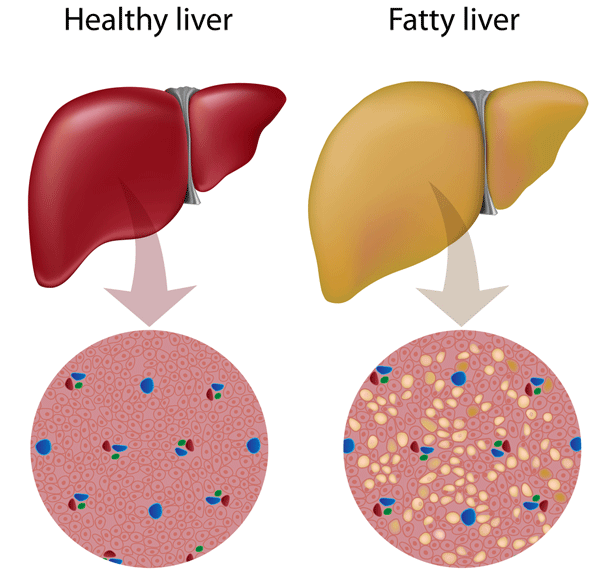Nutrition, Physiology
Treating hepatic steatosis or fatty liver disease with food
There are two major types of fatty liver disease — alcohol-induced and nonalcoholic fatty liver disease. Fatty liver disease affects nearly one-third of American adults and is one of the leading contributors to liver failure. Nonalcoholic fatty liver disease is most commonly diagnosed in those who are obese or sedentary and those who eat a highly processed diet.
One of the main ways to treat fatty liver disease, regardless of type, is with diet. As the name suggests, fatty liver diseasemeans you have too much fat in your liver. In a healthy body, the liver helps to remove toxins and produces bile, the digestive protein. Fatty liver disease damages the liver and prevents it from working as well as it should.
In general, the diet for fatty liver disease includes:
- lots of fruits and vegetables
- high-fiber plants like legumes and whole grains
- very little added sugar, salt, trans fat, refined carbohydrates, and saturated fat
- no alcohol
A low-fat, reduced-calorie diet can help you lose weight and reduce the risk of fatty liver disease. Ideally, if you’re overweight, you would aim to lose at least 10 percent of your body weight.
Here are a few foods to include in your healthy liver diet:
1. Coffee to lower abnormal liver enzymes
Studies have shown that coffee drinkers with fatty liver disease have less liver damage than those who don’t drink this caffeinated beverage. Caffeine appears to lower the amount of abnormal liver enzymes of people at risk for liver diseases.
2. Greens to prevent fat buildup
Broccoli is shown to help prevent the buildup of fat in the liver in mice. Eating more greens, like spinach, Brussels sprouts, and kale, can also help with general weight loss. Try the Canadian Liver Foundation’s recipe for vegetarian chili, which lets you cut back on calories without sacrificing flavor.
3. Tofu to reduce fat buildup
A University of Illinois study on rats found that soy protein, which is contained in foods like tofu, may reduce fat buildup in the liver. Plus, tofu is low in fat and high in protein.
4. Fish for inflammation and fat levels
Fatty fish such as salmon, sardines, tuna, and trout are high in omega-3 fatty acids. Omega-3 fatty acids can help improve liver fat levels and bring down inflammation. Try this teriyaki halibut recipe, recommended by the Canadian Liver Foundation, that’s especially low in fat.
5. Oatmeal for energy
Carbohydrates from whole grains like oatmeal give your body energy. Their fiber content also fills you up, which can help you maintain your weight.
6. Walnuts to improve the liver
These nuts are high in omega-3 fatty acids. Research finds that people with fatty liver disease who eat walnuts have improved liver function tests.
7. Avocado to help protect the liver
Avocados are high in healthy fats, and research suggests they contain chemicals that might slow liver damage. They’re also rich in fiber, which can help with weight control. Try this refreshing avocado and mushroom salad from Fatty Liver Diet Review.
8. Milk and other low-fat dairy to protect from damage
Dairy is high in whey protein, which may protect the liver from further damage, according to a 2011 study in rats.
9. Sunflower seeds for antioxidants
These nutty-tasting seeds are high in vitamin E, an antioxidant that may protect the liver from further damage.
10. Olive oil for weight control
This healthy oil is high in omega-3 fatty acids. It’s healthier for cooking than margarine, butter, or shortening. Research finds that olive oil helps to lower liver enzyme levels and control weight. Try this liver-friendly take on a traditional Mexican dish from LiverSupport.com.
11. Garlic to help reduce body weight
This herb not only adds flavor to food, but experimental studies also show that garlic powder supplements may help reduce body weight and fat in people with fatty liver disease.
12. Green tea for less fat absorption
Data supports that green tea can help interfere with fat absorption, but the results aren’t conclusive yet. Researchers are studying whether green tea can reduce fat storage in the liver and improve liver function. But green tea also has many benefits, from lowering cholesterol to aiding with sleep.
There are definitely foods you should avoid or limit if you have fatty liver disease. These foods generally contribute to weight gain and increasing blood sugar.
Avoid
- Alcohol. Alcohol is a major cause of fatty liver disease as well as other liver diseases.
- Added sugar. Stay away from sugary foods such as candy, cookies, sodas, and fruit juices. High blood sugar increases the amount of fat buildup in the liver.
- Fried foods. These are high in fat and calories.
- Salt. Eating too much salt can make your body hold on to excess water. Limit sodium to less than 1,500 milligrams per day.
- White bread, rice, and pasta. White usually means the flour is highly processed, which can raise your blood sugar more than whole grains due to a lack of fiber.
- Red meat. Beef and deli meats are high in saturated fat.
Here’s what your menu might look like during a typical day on a fatty liver diet plan:
*the plan below is a sample without micros calculations according
| Meal | Menu |
| breakfast | • 8 oz. hot oatmeal mixed with 2 tsp. almond butter and 1 sliced banana • 1 cup coffee with low-fat or skim milk |
| lunch | • spinach salad with balsamic vinegar and olive oil dressing • 3 oz. grilled chicken • 1 small baked potato • 1 cup cooked broccoli, carrots, or other vegetable • 1 apple • 1 glass of milk |
| snack | • 1 tbsp. peanut butter on sliced apples or 2 tbsp. hummus with raw veggies |
| dinner | • small mixed-bean salad • 3 oz. grilled salmon • 1 cup cooked broccoli • 1 whole-grain roll • 1 cup mixed berries • 1 glass of milk |
In addition to modifying your diet, here are a few other lifestyle changes you can make to improve your liver health:
- Get more active. Exercise, paired with diet, can help you lose extra weight and manage your liver disease. Aim to get at least 30 minutes of aerobic exercise on most days of the week.
- Lower cholesterol. Watch your saturated fat and sugar intake to help keep your cholesterol and triglyceride levels under control. If diet and exercise aren’t enough to lower your cholesterol, ask your doctor about taking medication.
- Control diabetes. Diabetes and fatty liver disease often occur together. Diet and exercise can help you manage both conditions. If your blood sugar is still high, your doctor can prescribe medication to lower it.
There are currently no drugs on the market that are approved by the U.S. Food and Drug Administration for fatty liver disease. While losing 10 percent of your weight is ideal, even just 3 to 5 percent can help. Ask your doctor to check your blood for the hepatitis A and B vaccines as well. These can help prevent viruses from causing liver damage.

